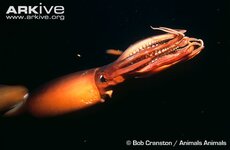Abstract
Dosidicus gigas, the Humboldt squid, is endemic to the eastern Pacific, and its range has been expanding poleward in recent years. It is a voracious predator of small fish and invertebrates and prominent prey for large fish and mammals, including humans. Very little is known about Humboldt squid reproduction, development, and early life stages. To study the behavior, including dispersal capabilities, of paralarval D. gigas, I analyzed video of animals swimming in the laboratory, and determined that paralarvae are active swimmers that engage in hop-and-sink behavior. Control of the mantle aperture allows them to engage in slow swimming, in which water is leaked through the mantle aperture, and fast jetting, in which the mantle aperture is tightly
closed and all water is expelled through the siphon—as is typical of adult jetting. A theoretical model of squid swimming was built to study the importance of aperture control during the jet cycle. This model predicts that active reduction of the aperture during jetting increases hydrodynamic efficiency, and that squid of large sizes can constrain the risk of embolism by increasing aperture size and decreasing jet frequency to values comparable to empirical measurements. Connectivity among populations of D. gigas throughout the range of this species was assessed with a population genetic approach, in which D. gigas was compared to the co-occurring squid Sthenoteuthis oualaniensis. In D. gigas, only two weakly differentiated populations were evident, with a biogeographic break at 5-6° N. I uncovered four deeply divergent clades in S. oualaniensis, including one which aligns with previous descriptions in the literature of Sthenoteuthis sp. nov. Breaks between clades of S. oualaniensis also occurred at 5-6° N. Range overlap between these two species occurs in the eastern tropical Pacific (ETP), a region both are believed to use as spawning grounds. I looked for paralarvae of D. gigas and S. oualaniensis in surface and subsurface net tows taken in the ETP from 1998 to 2006, and found that abundance was much greater in surface than subsurface tows. I then used a Generalized Linear Model approach to assess the importance of in situ oceanographic variables as predictors of paralarval incidence. ivSea surface temperature was found to be a strong predictor of incidence in both surface and subsurface tows, with the probability of paralarval capture rising
monotonically from near zero at 15 °C to 0.9 at 30 °C. The apparent lack of paralarvae at surface temperatures below 15 °C raises a question of whether D. gigas can spawn in the temperate and even subpolar waters of its expanded range. I conducted in vitro fertilization studies and found the optimal temperature range for successful laboratory development of D. gigas is 15-25° C.



